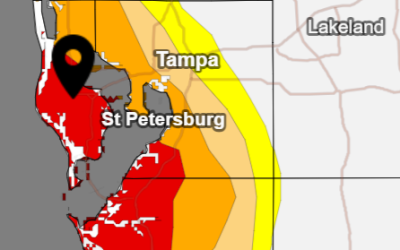The incredible Monarch butterfly is well known for undertaking long-distance journeys of 1500 miles or more. It’s an amazing feat considering its tiny body size and light weight. Now consider the fact that it undertakes this migration twice in its lifetime; first in autumn, when it flies to a site in central Mexico and back in spring, when it returns north to reproduce.
In Florida, there are also small resident populations of Monarch butterflies that take advantage of the warm climate to breed year-round in southern portions of the state. But the Monarch population is dwindling, with scientists noting a long-term trend of sharp declines due to loss of natural habitat, in particular native milkweeds.
Enemy#1 For The Monarch Butterfly: Tropical Milkweed
Monarchs feed primarily on milkweed plants (Asclepias species). But not all milkweeds are the same. Remember, it is native milkweeds that the Monarchs need to survive. The spread of non-native Tropical Milkweed (Asclepias currasivica), which is the most common commercially available species of milkweed, is having a negative impact on the population of Monarchs. This particular specie has showy flowers, is easy to grow, and has spread to natural areas and open pastures in Florida. But Tropical Milkweed may be contributing to the decline of the Monarch butterfly species, which will inevitably weaken the entire ecosystem.
How Is Tropical Milkweed Killing Monarch Butterflies?
There are a number of potential negative effects on Monarchs due to the spread of non-native Tropical Milkweed.
- Disruption Of Normal Migratory Cycle For Monarchs
When Tropical Milkweed is planted in the coastal U.S., these plants continue to flower throughout the fall and winter—except for during rare freeze events. And due to the availability of Tropical Milkweed all-year round in the U.S., the Monarchs are not finishing their fall migration, which is adversely affecting monarch breeding during this time. Monarchs are staying longer in areas where they would not normally stay over winter; therefore, subjecting them to devastating freezes.
- Spread Of Deadly Diseases In Monarch Butterflies
Because Monarch butterflies are staying longer in the United States, they are exposed to a deadly protozoan parasite known as Ophryocystis elktroscirrha (OE). The deadly disease spores of OE build up on overused Tropical milkweed plants. Continuous breeding on the same plants can lead to the OE infection being spread to Monarchs too. This is then being passed from infected butterflies to healthy ones.
Recent research studies show prolonged exposure to parasites, increased risk of infection, and spread of more virulent parasite genotypes in Monarchs. This is a huge problem mainly in U.S. coastal regions including Florida, Texas, and Southern California.
- Use of Toxic Insecticides Kill Monarch Eggs
The overuse of systemic insecticides in gardens may be killing caterpillars. Deadly poison often persists in the plant tissues of Milkweed plants bought from non-native nurseries as they are more likely to have been treated with such insecticides. Female monarchs that feed on treated milkweed lay eggs that do not hatch.
Choose Native Milkweed
Though there are twenty native species of milkweed in Florida, only three varieties are generally available in nurseries: Butterfly Milkweed (Asclepias tuberosa), Swamp Milkweed (Asclepias incarnate) and Aquatic Milkweed (Asclepias perennis). The Florida Association of Native Nurseries program is working to increase Florida’s regional (North, Central, South) ecotypes to stimulate production of native milkweed species. This will mean that more native milkweed plants can be made available for gardeners to help sustain Monarchs and other types of butterflies including Queen and Soldier for the long haul. Ask growers and local nurseries for native ecotype milkweed for your projects.
By planting the correct type of species of native milkweed, you can help maintain a safe and natural food source for monarchs, creating healthier populations.
Overuse is not a problem with native milkweeds because the leaves are only desirable to Monarchs during the early part of the growth cycle, unlike that of non-native Tropical Milkweed that remain desirable from first leaf to first frost. Native milkweed species will not disrupt the migratory patterns of Monarchs during fall.
3 Things Gardeners Can Do to Help Save The Monarch Butterfly
You can make your landscape friendly for Monarchs throughout their lifecycle by creating a safe environment for them to lay eggs, sip nectar, or find shelter on nippy evenings.
- Plant more native milkweeds such as Swamp Milkweed. Native milkweeds are favorites for Monarchs to lay eggs on and also for caterpillars to eat.
- Since Monarchs are insects, spraying insecticides will kill them. So, avoid spraying pesticides in your yard. Encourage natural controls such as birds and beneficial insects, with the use of native plants for food sources, nesting opportunity, and shelter, for maintaining balance in your landscape.
- Create a Monarch habitat garden in your yard by providing food, water, and shelter to raise their young. Besides planting native milkweeds for food, make sure to create shallow divots in bare soil for butterflies to land on safely and keep them moist so they can sip water. Monarchs cannot fly when they are cold so place large, flat rocks in places that receive morning sun so that the Monarchs can warm up by resting on them.
Join us at Wilcox Nursery And Landscaping in ensuring that Monarchs have a bright future and commit to being part of the solution to reverse the decline. We offer native milkweed plants and local expertise and resources about the ideal habitat for monarchs and other wildlife.



